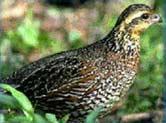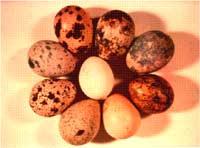QUAIL FARMING

The Quail called "bater" in Hindi, is a small type of bird that belongs to the Pheasant family. They were first domesticated in Japan in 1595. There are two species of quail in India; the black-breasted quail found in jungle (Coturnix Coromandelica) and the brown-coloured Japanese Quail (Coturnix Coturnix Japonica) which is bred for meat or the one used for commercial Quail production. They were introduced in India in 1974 from California.
There are 45 species of quail. Although the Japanese quail is the largest species, it is much smaller then pigeon. While Indian quail weighs up to 100 gm and lays 100 eggs a year, the Japanese quail weighs up to 250 gm and lays 250 eggs a year.
Though the Government of India is encouraging entrepreneurs to start quail farm, a government license is required to sell commercial Japanese quail considering the jungle variety of the bird, which is a protected species. The Ministry of environment and forests delegated the power to grant such license to the department of Animal husbandry. So, far more then 500 license has been issued in Maharashtra State alone.
Quail egg is roughly one-fifth the size of a chicken's egg and weigh around 10gm. The eggshells are spotted, with colors ranging from white to brown. Nutritionally, the quality of these eggs is at par with that of chicken eggs; rather they contain less cholesterol. The proportion of yolk (the yellow inside part) to albumen (the white part), at 39:61, is higher compared to chicken eggs.
Composition of Quail Egg (Whole, Raw)

Water |
Protein |
Fat |
Carbohydrate |
Total ash |
Calorific Value |
74% |
13% |
11% |
1% |
1% |
649 k J/100g liquid |
Quail meat / egg or as such the products are now widely accepted in India. The popularity can be judged by the factors like growing number of farms and market price which is Rs.16/ per live adult bird of 100-200 gms (Rs. 90-110 a kg Dressed meat) and Rs.0.15-0.20/ per egg. Small size of quail egg limits its popularization as alternative to chicken egg. However, they make attractive snacks or salad ingredients. Value addition is possible with products like egg pickles, brined quail eggs etc.
Quails have certain distinct characteristics that made them suitable for both egg as well as meat production. These are:
- Early marketing age (Five weeks for meat purposes, which is slightly below six weeks for broiler chicken)
- Early sexual maturity (They require six to seven weeks of age to produce eggs)
- High rate of lay (280 eggs per year)
- Occupation of a minimum floor space (Eight to ten birds can be kept in the same space housing a single chicken)
Quail possess a dressing proportion of about 70% (just like chicken), with the breast and thigh portion contributing nearly 68% of the total carcass. Egg production starts when the female quail reaches six to seven weeks of age and it touches 85% production by the end of 10 weeks.
iNCUBATION
Incubators that are used for hatching chicken eggs can be used for quail eggs with little modification. A wire mesh or grid of 1.5 x 1 inch should be fitted on the setter trays, to keep very small quail eggs in the incubator. Incubation period for quail eggs is 18 days. Incubation requirement are as follows:
Duration (Days) |
Temperature (deg.F) |
Humidity (%) |
Turning of Eggs |
0-14 |
99.5 |
60 |
Through 45 deg. 5-6 times a day. |
15 to 18 |
98.5 |
70 |
Not required |
If you are going for such operations of producing chicks at your farm, following information may be of help to you:
- Male / female ratio in the parent stock should be 1:2 or less.
- Quails start laying eggs at the age of 6 weeks, Quails lay most of the eggs during evening hours (Between 3 to 6 PM).
- Fertile eggs from the female of age 10 to 20 weeks can be collected for incubation. Eggs should be collected very frequently and carefully, as shells of eggs are very thin and they break very easily.
- Eggs should be stored at 55 deg.F with 70% relative humidity before incubation. You need to fumigate the eggs before incubation.
Rearing of quils
Quails can be reared on the floor or in the cages. The space requirement is as follows:
Please Note:
Following specifications are suggestive only and is meant for giving you some idea. You may need to take help qualified consultants.
Age
(in Weeks) |
Space Requirement
(cm.sq. / bird) |
Feeding Sapce
(cm.sq. / bird) |
Watering Space
(cm.sq. / bird) |
| |
Deep litter system* |
Cage system |
|
|
0-4 |
75 |
75 |
2.0 |
1.0 |
5-6 |
200 |
150 |
2.5 |
1.5 |
6 onwards |
250 |
175 |
2.5-3.0 |
1.5 |
| * A system of raring birds on the floor. |
Preparation of feed for quails.
Offer ground maize to quails (of 3week age) for first two days. After that, feed can be prepared by using commonly available ingredients like Maize, Rice polishing, Soybean extraction, groundnut extraction, Sunflower extraction etc. Commercial poultry feed that are available in the market are not suitable as it contains less protein than what is required for quails. However, it can be modified by adding more of soybean extraction or any other suitable protein source that are acceptable for quails. In India, at present commercial feed for quail is not available, one has to specially get it prepared.
Following is the approved Nutrient requirement for quails: Please check modified commercial preparation for these standards. If you are going for own farm mixing of raw ingredients, ask a nutrition consultant for a suitable mixing formula. You may need to take help of a feed analytical laboratory.
Nutrients |
Broiler Quails |
Layer Quail (For Egg) |
|
Starter
(0-4 wks.) |
Finisher
(4-6 wks.) |
Starter
(0-4 wks.) |
Grower
(4-5 wks.) |
Layer
(> 6 wks.) |
Energy (Kcal /Kg) |
2800 |
2800 |
2750 |
2750 |
2700 |
Protein % |
27 |
24 |
24 |
20 |
19 |
Calcium % |
0.8 |
0.6 |
0.8 |
0.6 |
3.0 |
Phosphorus % |
0.3 |
0.3 |
0.3 |
0.3 |
0.45 |
Disease incidence
Quails are comparatively sturdy birds, hence do not require any vaccination. Common disorders, which occur in case of chicken, are seldom noted in quails. Ulcerative enteritis is common in quails.
Economics of Quail farming under cage rearing system
|
|
|
|
|
Brooder size |
6'x2.6'x0.9' |
|
Mortality (%) |
6 |
Brooder Space s.ft/bird |
0.16 |
5 wk Body wt.(g) |
190 |
|
Weekly prod. |
500 |
Feed req.(kg) |
0.62 |
No. of Pen |
6 |
| |
Sl. |
Particulars |
|
Unit |
Qty. |
Unit rate (Rs.) |
Total (Rs.) |
I |
Non-recurring Expenditue |
|
|
|
a. |
Building 16'x16'x7' |
Sq.ft |
256 |
100 |
25600 |
|
including office space |
|
- |
- |
|
b. |
Battery brooders with equipments |
no. |
6 |
7000 |
42000 |
|
Total (A) |
|
|
|
|
67600 |
II |
Recurring Expenditue |
(for one year) |
|
|
a. |
Day old chicks |
no. |
27560 |
5 |
137800 |
b. |
Feed |
|
kg. |
16120 |
8.5 |
137020 |
c. |
Water/Elect./Medicine |
no. |
27560 |
1 |
27560 |
d. |
Labour |
|
Man-months |
12 |
1500 |
18000 |
|
Total (B) |
|
|
|
|
320380 |
III |
Capital Requirement |
|
|
|
|
a. |
Building & equipment |
- |
- |
- |
67600 |
b. |
Chicks |
|
no. |
2650 |
5 |
13250 |
c. |
Feed |
|
kg. |
775 |
8.5 |
6587.5 |
d. |
Water/Elect./Medicine |
no. |
2650 |
1 |
2650 |
e. |
Labour |
|
Man-months |
1.25 |
1500 |
1875 |
|
Total (C) |
|
|
|
|
91962.5 |
IV |
Income |
|
|
|
|
|
a. |
Broilers |
|
no. |
26000 |
16 |
416000 |
b. |
Manure |
|
tonne |
13 |
450 |
5850 |
c. |
Gunny bags |
no. |
230.29 |
10 |
2302.86 |
|
Total (D) |
|
|
|
|
424152.86 |
V |
Gross Profit (E=D-B) |
|
|
|
103772.86 |
VI |
Over head cost |
|
|
|
|
a. |
Depreciation on building |
- |
5.00% |
1280 |
b. |
Depreciation on battery brooders |
- |
10.00% |
4200 |
c. |
Interest on capital investment |
- |
12.00% |
11035.5 |
d. |
Maintenance of building and equip. |
|
5.00% |
3380 |
|
Total (F) |
|
|
|
|
19895.5 |
VII |
Net profit (E-F) |
|
|
|
83877.36 |
VIII |
Net profit per bird |
|
|
|
3.23 |
|
Net profit per kg |
|
|
|
16.98 |
|
Capital requirement per bird started |
|
34.7 |
|
Input output ratio |
|
|
|
1.25 |
To get birds for rearing contact.
- Director
Central Avian Research Institute,
Izatnagar, Dist. Bareilly, Uttar Pradesh, Pin: 243122
- A.V.M Hatcheries & Poultry Breeding Center Pvt. Ltd.
25 / 327, Rangai Gauder Street, Coimbatore Pin: 641001
- Director, Central Poultry Breeding Farm, Government of India located at :
- Aarey colony, Goregaon (E), Mumbai.- 400065
- Hessarghatta, Bangalore (North)-560088
- Nayapalli, Bhubaneshwar-751012
- Industrial Area, Chandigarh-160002
An improved strain of Japanese quail (Nandanam Quail-2), which attains body weight of 160 gm in five weeks, has been developed by poultry breeders at the Poultry Research Station, Tamil Nadu Veterinary and Animal Sciences University, Nandanam, Chennai.
-
M/s Venkateshwar Hacheries Pvt. Ltd.
Quail Unit at Naigaon, Pune
C/o Dr. B.V. Rao, IPMT
At/PO - Urulikanchan, Pune - 412202
Ph: 020 65782252, 26926509
Email : ipmtpune@vsnl.com
Source: http://www.vethelplineindia.com/art_quails.htm. |


